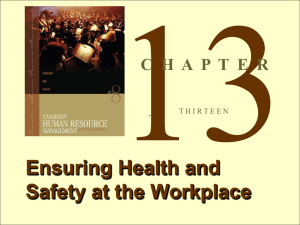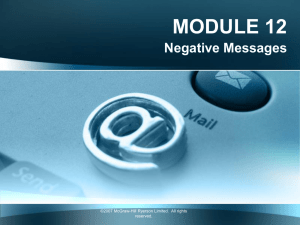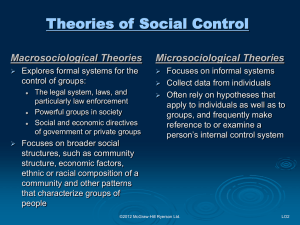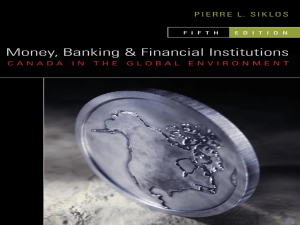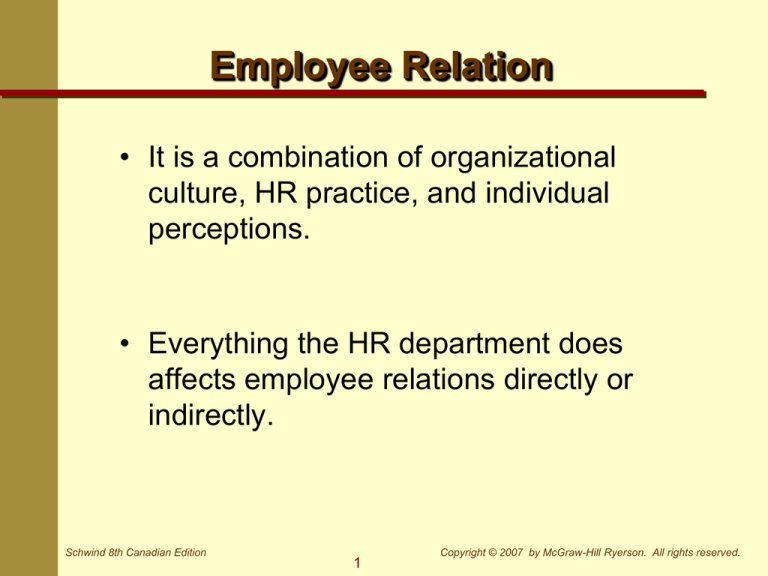
Employee Relation
• It is a combination of organizational
culture, HR practice, and individual
perceptions.
• Everything the HR department does
affects employee relations directly or
indirectly.
Schwind 8th Canadian Edition
1
Copyright © 2007 by McGraw-Hill Ryerson. All rights reserved.
Importance of Employee Relations
Improve
productivity
• Productivity is significantly impacted by
ability and attitude
Implementation of
organizational
strategies
• Goals and strategies are communicated
• Employees provide their commitment
Reduce
employment
costs
• Have concern and interest in employees
• Reduced absenteeism and turnover
Help employees
grow and develop
• Help employees achieve personal goals
• Improved morale, loyalty and productivity
Schwind 8th Canadian Edition
2
Copyright © 2007 by McGraw-Hill Ryerson. All rights reserved.
Key Dimensions of Employee
Relations
Employee
Communication
Employee
Involvement
Good Employee
Relations
Employee
Rights
Schwind 8th Canadian Edition
Employee
Counselling
Employee
Discipline
3
Copyright © 2007 by McGraw-Hill Ryerson. All rights reserved.
Employee Communication
Downward communication: is information that
begins at some point in the organization and
proceeds down the organizational hierarchy to
inform or influence other.
In-House publications: Job post must be posted on
bulletin board or online
Information booklet: Employee
handbook with information on
company regulations and
benefit
Schwind 8th Canadian Edition
4
Copyright © 2007 by McGraw-Hill Ryerson. All rights reserved.
Prerecorded message: Developing own TV
program that is viewed by the employees in
company lunchroom or other location.
Electronic communication: using email, blackberry
for communication
Information sharing and open-book management:
providing reports about organization’s economic
performance followed by meetings. Employees are
invited to question management.
Schwind 8th Canadian Edition
5
Copyright © 2007 by McGraw-Hill Ryerson. All rights reserved.
Employee Communication
Upward communication: consists of
information initiated by people who seek to
inform or influence those higher up in the
organization.
Grapevine: off-the-record
feedback from employees
like grievance issues, job
dissatisfaction, difficulties
with supervisors
Schwind 8th Canadian Edition
6
Copyright © 2007 by McGraw-Hill Ryerson. All rights reserved.
Electronic communication: using email, blackberry for
communication
In-house complaint procedure: formal method of
registering complaint.
written complaint >> investigation >> advise of
results.
Manager-employee meeting: meetings between
managers and groups of employees to discuss
complaints, suggestions, opinions, and questions.
Schwind 8th Canadian Edition
7
Copyright © 2007 by McGraw-Hill Ryerson. All rights reserved.
Suggestion systems: formal method (suggestion
form) of generating evaluating and implementing
employees ideas.
Employee attitude/opinion survey: What do
employees think about the organization? Do they
have any problems? Do they understand the HR
department benefit plan?
Schwind 8th Canadian Edition
8
Copyright © 2007 by McGraw-Hill Ryerson. All rights reserved.
Employee Counselling
Discussion of a problem with an employee and help
the worker cope with the situation
• Counselling Functions
–
–
–
–
–
–
Advice: guiding employees
Reassurance: courage to build up confidence
Communication: initiating upward communication
Release of emotional tension: emotional release
Clarified thinking: help think clearly about problem
Reorientation: reorient personal values and recognize
own limitations
• Employee & Family Assistance Programs (EFAP):
assists employees with personal problem – marital
difficulties, abuse.
Schwind 8th Canadian Edition
9
Copyright © 2007 by McGraw-Hill Ryerson. All rights reserved.
Employee Discipline
Management action to encourage compliance
with the organization’s standards
• Preventive Discipline
– Action taken prior to any offence or violation to
encourage employees to follow the rules
• Corrective Discipline
– Action taken after any offence or violation. This
disciplinary action is typically a penalty
Schwind 8th Canadian Edition
10
Copyright © 2007 by McGraw-Hill Ryerson. All rights reserved.
Employee Discipline
• Due Process
– Following proper rules and procedures for
disciplinary actions and giving employees the
opportunity to respond to allegations
• Progressive Discipline
– The use of stronger and stronger penalties for
repeated offences
• Hot-Stove Rule
– Warning, immediate, consistent, & impersonal
Schwind 8th Canadian Edition
11
Copyright © 2007 by McGraw-Hill Ryerson. All rights reserved.
Positive Discipline
• Employee acknowledges that a problem
exists
• Employee acknowledges that he or she
must assume responsibility for the
behaviour
• A problem-solving approach is used to
resolve the problem
Schwind 8th Canadian Edition
12
Copyright © 2007 by McGraw-Hill Ryerson. All rights reserved.
Dismissal
Termination of employee
• Wrongful Dismissal
– Dismissal without just cause or reasonable
notice of termination
Schwind 8th Canadian Edition
13
Copyright © 2007 by McGraw-Hill Ryerson. All rights reserved.
• Just Cause for Dismissal
– Dismissal under legal grounds
– Incompetent work performance: inability to
carry out job duties
– Employee misconduct: unfaithful service,
theft, fraud, disobedience
– Business or economic reason: declining
demand, organizational downsizing
Schwind 8th Canadian Edition
14
Copyright © 2007 by McGraw-Hill Ryerson. All rights reserved.
• Constructive
dismissal
- A major change in
the employment
contract that results
in an employee
resigning
- significant change in
job function,
demotion, demand
for an employee’s
resignation, forced
transfer.
Schwind 8th Canadian Edition
15
Copyright © 2007 by McGraw-Hill Ryerson. All rights reserved.
• Reasonable Notice
– When an employer does
not have just cause for
dismissal “reasonable
notice” or compensation in
lieu of notice is required
– Considers employee’s age,
length of service, salary,
occupational status, labour
market conditions
Schwind 8th Canadian Edition
16
Copyright © 2007 by McGraw-Hill Ryerson. All rights reserved.
• The Wallace “Effect”
– Requires good faith and fair
dealing in the termination of
employees
– damages designed to compensate
an employee who was subjected to
“bad faith (unfair) dismissal” tactics
of their employer.
– Two aspects of “Wallace”
damages: 1) the nature of the
employer’s bad faith and 2) the
impact of this conduct on the
employee’s ability to find
alternative employment.
Schwind 8th Canadian Edition
17
Copyright © 2007 by McGraw-Hill Ryerson. All rights reserved.
Employee Rights
Privacy (unnecessary involvement
into the private lives of employees,
employee information security
Employee
Rights
Fair
Treatment (age, race,
gender, religion)
Business Closing or
Restructuring (Layoffs
under Federal legislation)
Schwind 8th Canadian Edition
18
Copyright © 2007 by McGraw-Hill Ryerson. All rights reserved.
Employee Involvement
Employee Involvement Interventions are -
• Self-Directed Work Teams or Groups
– Teams of workers who make decisions without a formal
supervisor
• High Involvement Work Practices
– HR practices are related to organizational performance, higher
productivity and improved financial performance through focus
on employment security, decentralization, high compensation,
extensive training, etc.
• Employee Self-Service
– Reducing the amount of administrative work. Productivity
applications (online retirement plan, health-benefit
management) and strategic applications (online recruitment and
skill management)
Schwind 8th Canadian Edition
19
Copyright © 2007 by McGraw-Hill Ryerson. All rights reserved.
Job Security & Downsizing
• No-Layoff Policies
– Employees who have job security are more
receptive to change and are more likely to be
innovative and “go the extra mile”
• Organizational Downsizing
– Reducing employment to improve efficiency,
productivity, and competitiveness
– Workforce reduction (layoff), work redesign
(examine work process, function,
product/services), systematic change (change in
the culture, attitude, value)
Schwind 8th Canadian Edition
20
Copyright © 2007 by McGraw-Hill Ryerson. All rights reserved.
Retaining Top Performers
• Develop a planned approach to employee
retention
• Become an employer of choice
• Communicate vision and values clearly, frequently
and consistently
• Reward managers for keeping good people
• Use exit interviews to obtain information (why
people are leaving the organization?)
Schwind 8th Canadian Edition
21
Copyright © 2007 by McGraw-Hill Ryerson. All rights reserved.


